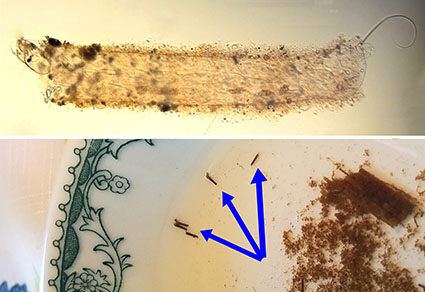Abstract
In this study, we describe Zavrelia parapentatoma sp. nov. based on specimens collected near a cattail marsh in Michigan, USA. At first glance, the new species resembles Zavrelia pentatoma Kieffer & Bause, 1913 closely. However, a detailed morphological and molecular assessment revealed the differences. Morphologically the two species can be separated mainly based on the shape and pattern of long spinulae between long anal crests of adult males and setal patterns on the pupal abdomen. Larvae of both species also have some subtle morphological differences that are discussed in this study. Our molecular analysis of cytochrome oxidase (COI) genes and methods for delimiting species further supported the presence of a new species. In this study, we describe all the life stages, provide life history observations for this new species, and provide keys to adult males and immatures of the genus Zavrelia.
References
Anderson, A.M., Stur, E. & Ekrem, T. (2013) Molecular and morphological methods reveal cryptic diversity and three new species of Nearctic Micropsectra (Diptera: Chironomidae). Freshwater Science, 32, 892–921. https://doi.org/10.1899/12-026.1
Bause, E. (1913) Preprint of Bause E. (1914) Die metamorphose der gattung Tanytarsus und einiger verwandter Tendipedidenarten. Archiv für Hydrobiologie Supplement, 2, 1–139.
Brundin, L. (1949) Chironomiden und andere Bodentiere der südschwedischen Urgebirgsseen: ein Beitrag zur Kenntnis der bodenfaunistischen Charakterzüge schwedischer oligotropher Seen. Institute of Freshwater Research, Drottningholm, Lund, 915 pp.
Carew, M.E., Pettigrove, V., Cox, R.L. & Hoffmann, A.A. (2007) DNA identification of urban Tanytarsini chironomids (Diptera: Chironomidae). Journal of the North American Benthological Society, 26, 587–600. https://doi.org/10.1899/06-120.1
Darriba, D. & Posada, D. (2014) jModelTest 2.0. Manual Version 0. 1.1. Available from: https://github.com/ddarriba/jmodeltest2
Drummond, A.J. & Rambaut, A. (2007) BEAST: Bayesian evolutionary analysis by sampling trees. BMC evolutionary biology, 7, 1–8. https://doi.org/10.1186/1471-2148-7-214
Ekrem, T. & Stur, E. (2009) A review of the genus Zavrelia (Diptera: Chironomidae). European Journal of Entomology, 106, 119. https://doi.org/10.14411/eje.2009.016
Folmer, R.H.A., Nilges, M., Folkers, P.J.M., Konings, R.N.H. & Hilbers, C.W. (1994) A model of the complex between single-stranded DNA and the single-stranded DNA binding protein encoded by gene V of filamentous bacteriophage M13. Journal of molecular biology, 240, 341–357. https://doi.org/10.1006/jmbi.1994.1449
Giłka, W. (2008) An intraspecific morphological variability of Zavrelia pentatoma Kieffer (Diptera: Chironomidae). Dipteron, Bulletin of the Dipterological Section of the Polish Entomological Society, 24, 11–15.
Giłka, W., Paasivirta, L., Gadawski, P. & Grabowski, M. (2018) Morphology and molecules say: Tanytarsus latens, sp. nov. from Finland (Diptera: Chironomidae). Zootaxa, 4471 (3), 569–579. https://doi.org/10.11646/zootaxa.4471.3.8
Hall, T.A. (1999) BioEdit: A user-friendly biological sequence alignment editor and analysis program for Windows 95/98/NT. Nucleic Acids Symposium Series, 41, 95-98.
Hebert, P.D., Ratnasingham, S., Zakharov, E.V., Telfer, A.C., Levesque-Beaudin, V., Milton, M.A., Pedersen, S., Jannetta, P. & DeWaard, J.R. (2016) Counting animal species with DNA barcodes: Canadian insects. Philosophical Transactions of the Royal Society B: Biological Sciences, 371, 20150333. https://doi.org/10.1098/rstb.2015.0333
Huelsenbeck, J.P. & Ronquist, F. (2001) MRBAYES: Bayesian inference of phylogenetic trees. Bioinformatics, 17, 754–755. https://doi.org/10.1093/bioinformatics/17.8.754
Kimura, M. (1980) A simple method for estimating evolutionary rate of base substitutions through comparative studies of nucleotide sequences. Journal of Molecular Evolution, 16,111–120. https://doi.org/10.1007/BF01731581
Kobayashi, T. (2014) A redescription of Zavrelia simantoneoa (Sasa, Suzuki and Sakai, 1998) comb. nov. CHIRONOMUS Journal of Chironomidae Research, 27, 41–44. h
ttps://doi.org/10.5324/cjcr.v0i27.1699
Kumar, S., Stecher, G., Li, M., Knyaz, C., & Tamura, K. (2018) MEGA X: Molecular Evolutionary Genetics Analysis across computing platforms. Molecular Biology and `Evolution, 35, 1547–1549. https://doi.org/10.1093/molbev/msy096
Larkin, M.A., Blackshields, G., Brown, N.P., Chenna, R., McGettigan, P.A., McWilliam, H., Valentin, F., Wallace, I.M., Wilm, A. & Lopez, R. (2007) Clustal W and Clustal X version 2.0. Bioinformatics, 23, 2947–2948. https://doi.org/10.1093/bioinformatics/btm404
Lin, X., Stur, E. & Ekrem, T. (2015) Exploring genetic divergence in a species-rich insect genus using 2790 DNA barcodes. PLoS ONE, 10, e0138993. https://doi.org/10.1371/journal.pone.0138993
Lin, X.L. & Wang, X.H. (2017) A redescription of Zavrelia bragremia Guo & Wang, 2007 (Diptera: Chironomidae). CHIRONOMUS Journal of Chironomidae Research, 30, 67–71. https://doi.org/10.5324/cjcr.v0i30.2345
Miller, M.A., Pfeiffer, W. & Schwartz, T. (2012) The CIPRES science gateway: enabling high-impact science for phylogenetics researchers with limited resources. In: Stewart, C. (Ed.), Proceedings of the 1st Conference of the Extreme Science and Engineering Discovery Environment: Bridging from the extreme to the campus and beyond, 2012, pp. 1–8.
Namayandeh, A. & Hudson, P.L. (2022) Two new Orthocladiinae (Diptera: Chironomidae) collected in overlooked places of Midwest USA. Zootaxa, 5099 (1), 120–128. https://doi.org/10.11646/zootaxa.5099.1.5
Puillandre, N., Lambert, A., Brouillet, S. & Achaz, G. (2012) ABGD, Automatic Barcode Gap Discovery for primary species delimitation. Molecular ecology, 21, 1864–1877. https://doi.org/10.1111/j.1365-294X.2011.05239.x
Puillandre, N., Brouillet, S. & Achaz, G. (2021) ASAP: assemble species by automatic partitioning. Molecular Ecology Resources, 21, 609–620. https://doi.org/10.1111/1755-0998.13281
Rambaut, A. (2014) FigTree. Version 1.4.2. Software. Institute of Evolutionary Biology, Univ. Edinburgh. Available from: http://tree.bio.ed.ac.uk/software/figtree/ (accessed 14 February 2023)
Sæther, O.A. (1977) Female genitalia in Chironomidae and other Nematocera: morphology, phylogenies, keys. Bulletin of the Fisheries Research Board of Canada, 197, 1–220.
Sæther, O.A. (1980) Glossary of chironomid morphology terminology (Diptera, Chiromodiae). Entomologica Scandinavica Supplement, 14, 1–51.
Stamatakis, A. (2014) RAxML version 8: a tool for phylogenetic analysis and post-analysis of large phylogenies. Bioinformatics, 30 (9), 1312–1313. https://doi.org/10.1093/bioinformatics/btu033
Sinclair, C.S. & Gresens, S.E. (2008) Discrimination of Cricotopus species (Diptera: Chironomidae) by DNA barcoding. Bulletin of Entomological Research, 98, 555–563. https://doi.org/10.1017/S0007485308005865
Song, C., Lin, X.-L., Wang, Q. & Wang, X.-H. (2018) DNA barcodes successfully delimit morphospecies in a superdiverse insect genus. Zoologica Scripta, 47, 311–324. https://doi.org/10.1111/zsc.12284
Song, C., Zhu, B.-Q., Moubayed-Breil, J., Lei, T. & Qi, X. (2022) Taxonomic study on the genus Stenochironomus Kieffer from the Baishanzu Nature Reserve, China (Diptera, Chironomidae). ZooKeys, 1104, 93–113. https://doi.org/10.3897/zookeys.1104.81403
Zorina, O.V. (2008) Russian Zavrelia Kieffer (Diptera: Chironomidae), with the description of two new species. Zootaxa, 1845 (1), 60–68. https://doi.org/10.11646/zootaxa.1845.1.4


